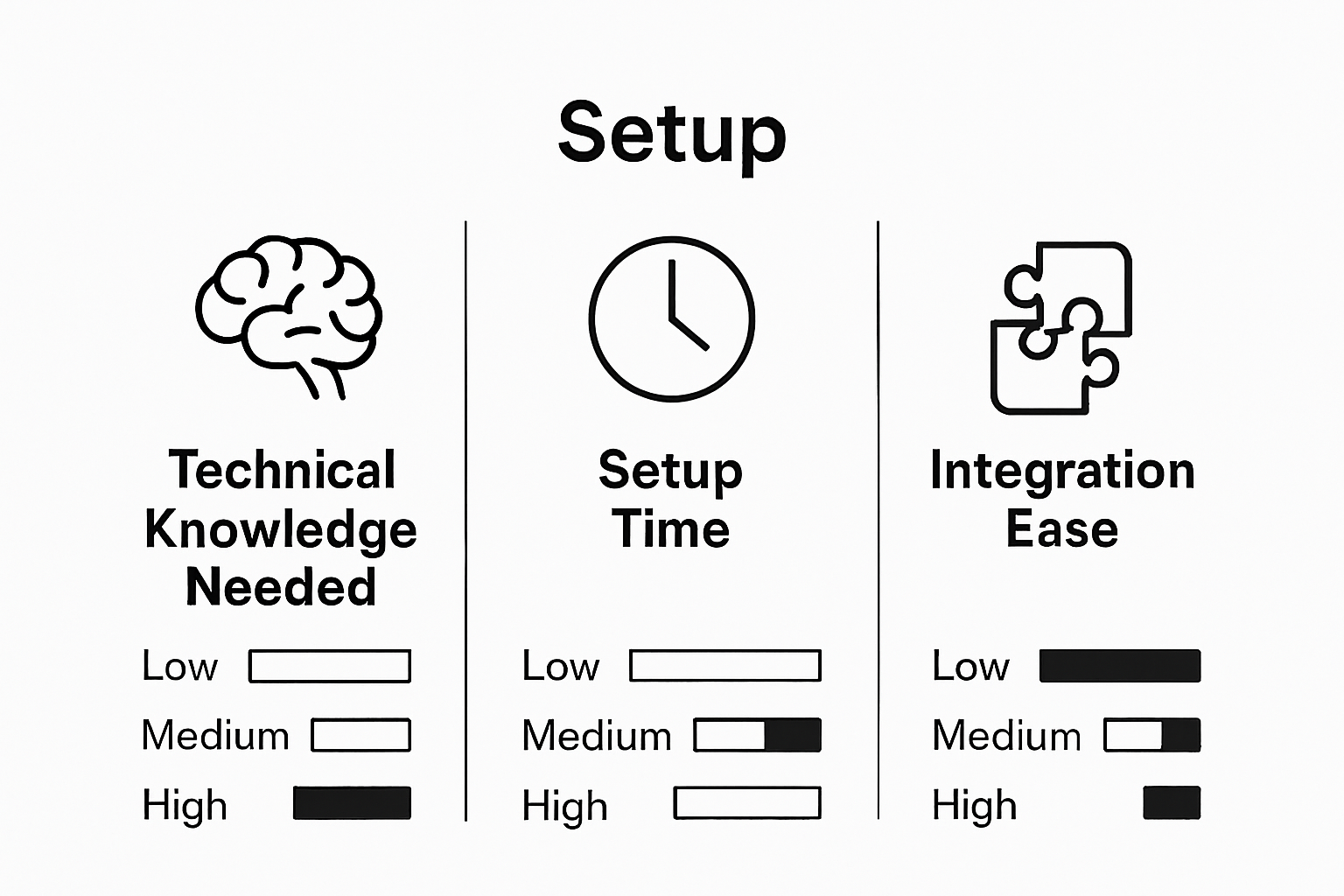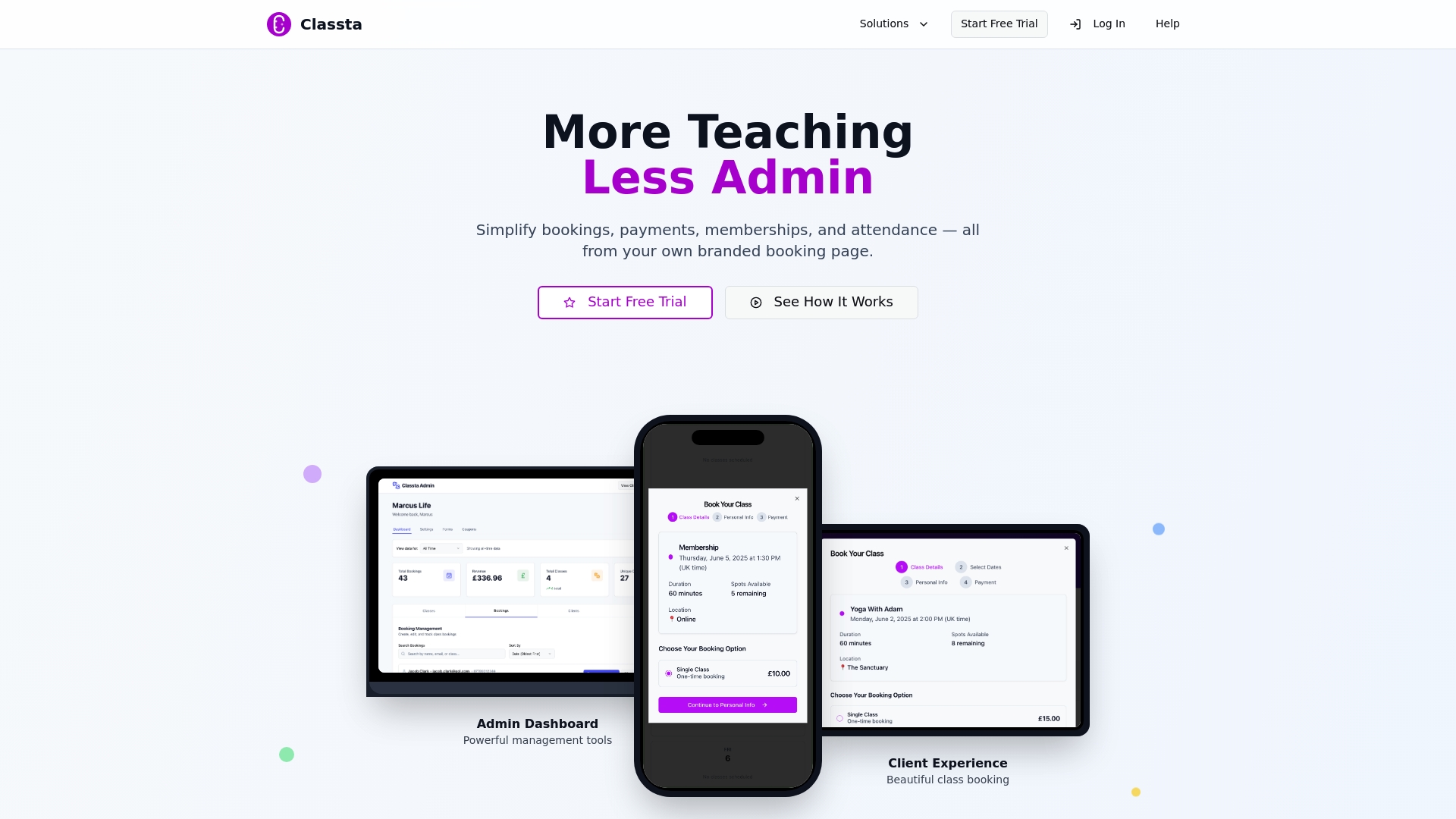Integrating new technology can feel overwhelming, especially when every minute counts in a busy fitness studio. Here is something shocking. Devices that are both useful and easy to set up are significantly more likely to be embraced by fitness professionals, according to recent research. You might expect that cutting-edge features steal the spotlight, but it is actually the simplicity of setup that shapes long-term success for instructors and clients alike.
Table of Contents
- Defining Ease of Setup In Fitness Contexts
- Importance Of Ease Of Setup For Instructors And Clients
- How Ease Of Setup Enhances Business Efficiency
- Key Factors Influencing Ease Of Setup In Fitness
- Real-World Examples Of Effective Setup Strategies
Quick Summary
| Takeaway | Explanation |
|---|---|
| Prioritise ease of setup in fitness technology | Streamlined implementations enhance workflow efficiency for trainers, allowing them to focus on client engagement instead of technical burdens. |
| Aim for minimal technical knowledge requirements | Solutions should be accessible to all fitness professionals, without the need for advanced technological skills, to encourage widespread adoption. |
| Ensure intuitive user interfaces | Systems designed with clear navigation reduce cognitive load and make onboarding easier, facilitating a positive user experience from the start. |
| Utilise adaptive setup methodologies | Customisable and incremental implementation strategies accommodate varying skill levels and business needs, leading to smoother transitions and less disruption. |
| Emphasise community support in implementation | Community-driven models foster collaborative learning, enabling fitness professionals to share knowledge and effectively adopt new technologies together. |
Defining Ease of Setup in Fitness Contexts
Ease of setup represents a critical factor determining how quickly and smoothly fitness professionals and instructors can implement new technologies, systems, or platforms into their existing workflows. Within the fitness industry, this concept goes beyond mere technical installation and encompasses the overall user experience of adopting a new solution.
Understanding the Core Concept
At its foundation, ease of setup involves several interconnected elements that determine how readily a fitness professional can integrate a new tool or technology. These elements include technical complexity, user interface intuitiveness, and time investment required for implementation.
According to research on wearable fitness technology, devices and platforms perceived as both useful and straightforward to implement are significantly more likely to be adopted by fitness professionals. This suggests that ease of setup is not just a technical consideration but a strategic business decision.
Key Components of Setup Simplicity
The role of ease of setup in fitness contexts can be broken down into several fundamental components:

- Minimal Technical Knowledge Required: Solutions that do not demand advanced technical skills
- Quick Configuration Process: Systems that can be operational within minutes
- Intuitive User Interface: Platforms with clear, logical navigation and setup procedures
- Seamless Integration: Ability to connect with existing tools and software ecosystems
Fitness instructors and studio owners typically seek solutions that allow them to focus on their core expertise training clients rather than wrestling with complex technological implementations. A truly user-friendly setup means professionals can transition smoothly without significant learning curves or substantial time investments.
Below is a table summarising the key components that define ease of setup in fitness technology, clarifying what each aspect means in a practical sense.
| Component | Description |
|---|---|
| Minimal Technical Knowledge | Solutions that can be implemented without requiring advanced IT skills or specialised training |
| Quick Configuration Process | Systems that function fully within minutes of setup |
| Intuitive User Interface | Interfaces with clear, logical menus and navigation that are simple to follow |
| Seamless Integration | The ability to connect smoothly with existing tools, platforms, or workflows |
By prioritizing ease of setup, fitness technology providers acknowledge that their primary users are movement professionals, not technical experts. The goal is to create solutions that feel like natural extensions of an instructor’s existing practice, enabling them to enhance their business operations with minimal friction.
Importance of Ease of Setup for Instructors and Clients
The importance of ease of setup extends far beyond technical convenience, representing a critical intersection between technological efficiency and professional effectiveness in fitness environments. For both instructors and clients, a seamless setup process can significantly impact engagement, productivity, and overall satisfaction.
Impact on Professional Workflow
For fitness professionals, an uncomplicated setup process directly translates to reduced administrative burden and more time dedicated to core teaching responsibilities. Research on fitness education programs highlights that administrative management is often considered the least critical competency, suggesting that streamlined technological solutions can help instructors focus on skill development and client interactions.
The setup process influences several critical professional aspects:
- Minimising time spent on technical configuration
- Reducing cognitive load associated with complex system navigation
- Enabling faster transition between administrative tasks and client engagement
- Creating a more professional and efficient operational environment
Client Experience and Trust
Clients inherently value platforms and systems that feel accessible and straightforward. A complex or frustrating setup can create immediate barriers to engagement, potentially deterring individuals from continuing with a fitness programme or service.
Key client considerations include:
- Perceiving the instructor as technologically competent
- Experiencing a smooth, professional onboarding process
- Feeling confident in the technological infrastructure supporting their fitness journey
- Maintaining motivation through user-friendly interfaces
By prioritising ease of setup, fitness professionals demonstrate respect for their clients’ time and cognitive resources. A well-designed, intuitive system communicates professionalism and commitment to delivering high-quality, accessible fitness experiences.
Ultimately, ease of setup is not merely a technical requirement but a strategic approach to building trust, enhancing client relationships, and creating a more streamlined, client-centric fitness environment.
How Ease of Setup Enhances Business Efficiency
Ease of setup serves as a fundamental catalyst for transforming operational performance in fitness businesses, enabling professionals to streamline administrative processes and allocate resources more strategically. By reducing technological complexity, fitness enterprises can create more agile and responsive business models.
Operational Resource Optimization
Operational efficiency emerges as a direct consequence of implementing systems with straightforward setup procedures. Research in legal aspects of sport management demonstrates that simplified technological implementation significantly contributes to reducing administrative overhead and enabling more effective resource allocation.
Key operational benefits include:
- Minimising time spent on technical configuration
- Reducing personnel training requirements
- Accelerating system implementation timelines
- Decreasing potential error margins during digital transitions
Financial and Strategic Advantages
A streamlined setup process presents substantial financial implications for fitness businesses. Reduced implementation complexity translates into lower initial investment costs and faster return on technological investments. The ability to quickly integrate new systems means businesses can respond more nimbly to market changes and client expectations.
Strategic advantages encompass:
- Lower technology adoption barriers
- Faster scalability of business operations
- Enhanced capacity for technological innovation
- Improved competitive positioning within the fitness market
By prioritising ease of setup, fitness businesses create an environment where technological solutions become enablers rather than obstacles. This approach allows instructors and management to focus on core business objectives: delivering exceptional fitness experiences and driving client transformation.
This table compares the operational and strategic benefits brought by prioritising ease of setup for fitness businesses, highlighting specific ways each advantage manifests in real practice.
| Category | Business Benefit | Example Outcomes |
|---|---|---|
| Operational | Minimise setup and training time | Quicker onboarding for new staff |
| Operational | Reduce administrative burden | Less time spent on technical troubleshooting |
| Strategic | Lower technology adoption barriers | Easier adoption of new platforms or systems |
| Strategic | Improved competitive positioning | Faster rollout of new client-facing services |
| Strategic | Enhanced innovation capacity | Ability to try new technologies with minimal risk |
| Financial | Lower upfront implementation costs | Reduced need for expensive IT consultants |
| Financial | Faster return on technological investments | More rapid achievement of business objectives |

Ultimately, ease of setup represents more than a technical consideration it is a strategic approach to building adaptable, efficient, and client-focused fitness enterprises.
Key Factors Influencing Ease of Setup in Fitness
The landscape of fitness technology demands sophisticated yet accessible solutions that accommodate diverse professional requirements. Understanding the key factors influencing ease of setup becomes crucial for developing systems that genuinely support fitness professionals and their clients.
Technical Infrastructure Considerations
Technical infrastructure represents the foundational layer determining setup complexity. System compatibility and integration capabilities emerge as primary determinants of how smoothly a new technological solution can be implemented within existing workflows.
Research examining fitness center accessibility underscores the importance of creating technological solutions that seamlessly align with existing operational frameworks. This requires careful consideration of several interconnected elements:
- Compatibility with existing software platforms
- Scalability across different business sizes
- Robust security protocols
- Minimal hardware requirements
User Experience and Interface Design
Beyond technical specifications, user experience plays a pivotal role in determining setup ease. An intuitive interface can dramatically reduce the cognitive load associated with implementing new technological systems. Fitness professionals seek solutions that feel like natural extensions of their existing practice rather than complex, intimidating platforms.
Key user experience factors include:
- Clarity of setup instructions
- Intuitive navigation pathways
- Minimal required technical knowledge
- Comprehensive yet concise onboarding processes
The goal is to create a setup experience that feels effortless and empowering.
By prioritising user-centric design, technology providers can transform potentially stressful technological transitions into smooth, confidence-building experiences.
Ultimately, ease of setup transcends mere technical functionality. It represents a holistic approach to supporting fitness professionals by reducing barriers, minimising friction, and enabling them to focus on their core mission of delivering exceptional fitness experiences.
Real-World Examples of Effective Setup Strategies
Real-world implementation of setup strategies demonstrates the profound impact of thoughtful technological integration in fitness environments. By examining practical approaches, fitness professionals can gain insights into creating seamless, user-friendly systems that enhance operational efficiency and client engagement.
Community-Driven Implementation Models
Research examining implementation strategies reveals that successful setup approaches often leverage community support and social dynamics. Collaborative implementation methods prove particularly effective in reducing technological adoption barriers and creating supportive learning environments.
Key characteristics of successful community-driven models include:
- Peer-to-peer learning networks
- Shared technological knowledge transfer
- Mutual problem-solving approaches
- Collective technological exploration
Adaptive Setup Methodologies
Fitness professionals are increasingly adopting flexible setup strategies that accommodate diverse technological skill levels and business requirements. These adaptive methodologies prioritise personalisation and incremental implementation, allowing businesses to integrate new systems without disrupting existing workflows.
Successful adaptive setup strategies typically feature:
- Modular implementation approaches
- Customisable onboarding processes
- Scalable technological solutions
- Comprehensive support mechanisms
By recognising that each fitness business possesses unique operational characteristics, adaptive setup strategies create tailored technological experiences. These approaches transform potential implementation challenges into opportunities for professional growth and technological empowerment.
Ultimately, effective setup strategies transcend technical configuration. They represent a holistic approach to technological integration that respects individual professional contexts, minimises potential friction, and creates pathways for continuous learning and development in fitness technology ecosystems.
Experience True Ease of Setup with Classta.co
Are you tired of struggling with complex booking systems and endless administrative burden? The article explored how simplicity, quick implementation and intuitive design can transform your professional life as an instructor. At Classta.co, our all-in-one SaaS platform is purpose-built for class providers who want a truly easy setup. You do not need technical expertise. Our streamlined onboarding, branded booking calendars and automated admin tools empower you to focus on client results rather than wrestling with tech hurdles.

It is time to see how effortless setup really feels. Discover why so many yoga, pilates and fitness instructors trust Classta.co for secure payments, client management and powerful automation. Visit our main site now to create a seamless client experience and free yourself from unnecessary technical headaches.
Frequently Asked Questions
What is meant by ‘ease of setup’ in the fitness industry?
Ease of setup in the fitness industry refers to the simplicity and speed with which fitness professionals can integrate new technologies or systems into their existing workflows. It includes aspects like technical complexity, user interface intuitiveness, and the time required for implementation.
Why is ease of setup important for fitness instructors?
Ease of setup is crucial for fitness instructors as it reduces the administrative burden and allows them to focus more on their core teaching responsibilities. A simple setup process minimises time spent on configuration and decreases cognitive load, leading to a more efficient operational environment.
How does a smooth setup process enhance client experience?
A smooth setup process enhances the client experience by making the onboarding process feel accessible and straightforward. This fosters trust, as clients perceive their instructors as highly competent, and encourages them to stay engaged with their fitness programmes.
What factors influence the ease of setup for fitness technology?
Factors that influence ease of setup for fitness technology include the technical infrastructure (such as system compatibility and integration capabilities) and user experience design (like clarity of setup instructions and intuitive navigation pathways). These elements work together to create a seamless user experience.
